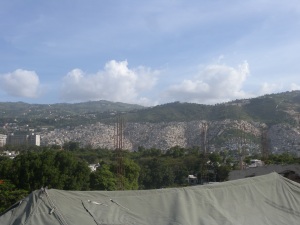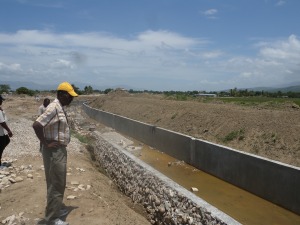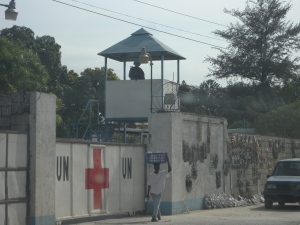Link to my latest post on Wordpress
A few months ago, I had the opportunity to visit Haiti as part of an Earth Institute visit to meet some of the newly appointed government officials from Haiti’s new Prime Minister Laurent Lamothe. Our main objective was to gain some on-site understanding of the main bottlenecks in the agriculture sector. There are a lot of studies and papers about this subject but seeing the rice fields with your own eyes adds a new dimension to any desk research. I was lucky enough to have professor Glenn Denning leading the mission. He has a very long and successful career as a rice specialist in Southeastern Asia and his coaching during our travels in the country allowed me to quickly grasp the agricultural policy situation in Haiti.

Haiti’s mountainous landscape limits the area that is suitable for investments in the intensification of agriculture. The Artibonite valley, in the central plateau, is Haiti’s “rice bowl”, producing up to 80% of the national rice production. Thanks to the construction of the Peligre Dam in the 1950s and a major irrigation system financed by German aid in the 1970s, the area has the potential to secure the country’s rice stocks and reduce food insecurity.

The Haitian government created the ODVA (Organization for the Development of the Artibonite Valley) in 1949 to take advantage of this area’s potential and to start what could be called a “Haitian Green Revolution”. Almost sixty years later and despite the relentless efforts of the organization to build and maintain water management infrastructure, the area produces yields comparable to what other tropical countries achieve with traditional rain-fed organic agriculture. The organization provides credit and in-kind transfers of basic imported inputs like seeds and fertilizer; it supports farmers in the acquisition of small mechanization tools. With these extension services and the irrigation infrastructure provided by ODVA the yields in the region should be up to three times higher for certain crops like rice. To better understand the reasons of these shortcomings we spent a full day in the Artibonite Valley visiting farmer fields, irrigation canals and meeting with ODVA staff.

We learned that one of the main issues that the organization is facing is the lack of funding to maintain infrastructure. One of the key elements is the inability of the organization to charge for the water it provides farmers with. The effective full subsidy of water resources, covered by ODVA, has critically limited the financial capacity of the ODVA to maintain secondary and tertiary canals in the valley. Without these canals, effective drainage and water management at the plot level is impossible causing yield levels to remain stagnant. This situation is worsened by the fact that the water comes from an upstream dam managed by EDH (Electricity of Haiti) whose work is totally uncoordinated from the needs of farmers in the valley. The Peligre dam represents more than 25% of the power generation capacity of the country and is fundamental to the country’s functioning; as a result water discharge is not synchronized with the agriculture needs in the region. The irrigation system provides either too much or too little water during the year. Another aspect to bear in mind is that imported rice is highly subsidized or even free, making the profitability of local production inexistent and forcing farmers to produce rice only for subsistence purposes. If all these factors weren’t enough, one needs to consider the land tenure issues in Haiti, having a higher-than-average productivity might lead to claims of land ownership by other farmers that could actually put in jeopardy any investment in the plot irrigation infrastructure. There are just no incentives for farmers to invest in productivity increases.

Supporters of market-based mechanisms argue that part of the solution to this inefficient situation would be to charge farmers for the water delivered to their plots to build and maintain secondary and tertiary canals. Another important aspect would be to reduce the subsidies in the rice market to boost local production, a protectionist measure that Haiti’s commercial partners probably wouldn’t support. Both options would mean political suicide given the current political deadlock in the country. The reality is that the very precarious situation of Haiti has created a vicious cycle in the agriculture sector. There are absolutely no incentives for the private sector to invest in Haitian agriculture and there are very important pressures by the donor community to avoid any kind of important government intervention.

Our job and the reason the ministry of agriculture has requested technical assistance from the Earth Institute is to support the ministry’s argument that the donor community has to invest in the sector having the government of Haiti act as the implementer of the projects. In this sense, the government needs to understand how much investment is needed in the sector to achieve yield levels that are in line with the two or even three times larger yield levels that similar Caribbean countries have already achieved.

The Earth Institute has been working with yield, production and fertilizer data to model the possible economic impacts of strategic agricultural interventions to boost productivity. Factoring this political gridlock into the models is impossible; economists often avoid theses types of situations by making certain key assumptions to avoid the hard realities that occur in the development arena. As a recent graduate from the MPA in Development Practice from Columbia University, I recognize that any form of effective policy recommendation will require going beyond the important desk based quantitative modeling. A true political reform is needed, one that recognizes the importance of starting a green revolution to Haiti.



 Haiti’s mountainous landscape limits the area that is suitable for investments in the intensification of agriculture. The Artibonite valley, in the central plateau, is Haiti’s “rice bowl”, producing up to 80% of the national rice production. Thanks to the construction of the Peligre Dam in the 1950s and a major irrigation system financed by German aid in the 1970s, the area has the potential to secure the country’s rice stocks and reduce food insecurity.
The Haitian government created the ODVA (Organization for the Development of the Artibonite Valley) in 1949 to take advantage of this area’s potential and to start what could be called a “Haitian Green Revolution”. Almost sixty years later and despite the relentless efforts of the organization to build and maintain water management infrastructure, the area produces yields comparable to what other tropical countries achieve with traditional rain-fed organic agriculture. The organization provides credit and in-kind transfers of basic imported inputs like seeds and fertilizer; it supports farmers in the acquisition of small mechanization tools. With these extension services and the irrigation infrastructure provided by ODVA the yields in the region should be up to three times higher for certain crops like rice. To better understand the reasons of these shortcomings we spent a full day in the Artibonite Valley visiting farmer fields, irrigation canals and meeting with ODVA staff.
Haiti’s mountainous landscape limits the area that is suitable for investments in the intensification of agriculture. The Artibonite valley, in the central plateau, is Haiti’s “rice bowl”, producing up to 80% of the national rice production. Thanks to the construction of the Peligre Dam in the 1950s and a major irrigation system financed by German aid in the 1970s, the area has the potential to secure the country’s rice stocks and reduce food insecurity.
The Haitian government created the ODVA (Organization for the Development of the Artibonite Valley) in 1949 to take advantage of this area’s potential and to start what could be called a “Haitian Green Revolution”. Almost sixty years later and despite the relentless efforts of the organization to build and maintain water management infrastructure, the area produces yields comparable to what other tropical countries achieve with traditional rain-fed organic agriculture. The organization provides credit and in-kind transfers of basic imported inputs like seeds and fertilizer; it supports farmers in the acquisition of small mechanization tools. With these extension services and the irrigation infrastructure provided by ODVA the yields in the region should be up to three times higher for certain crops like rice. To better understand the reasons of these shortcomings we spent a full day in the Artibonite Valley visiting farmer fields, irrigation canals and meeting with ODVA staff.
 We learned that one of the main issues that the organization is facing is the lack of funding to maintain infrastructure. One of the key elements is the inability of the organization to charge for the water it provides farmers with. The effective full subsidy of water resources, covered by ODVA, has critically limited the financial capacity of the ODVA to maintain secondary and tertiary canals in the valley. Without these canals, effective drainage and water management at the plot level is impossible causing yield levels to remain stagnant. This situation is worsened by the fact that the water comes from an upstream dam managed by EDH (Electricity of Haiti) whose work is totally uncoordinated from the needs of farmers in the valley. The Peligre dam represents more than 25% of the power generation capacity of the country and is fundamental to the country’s functioning; as a result water discharge is not synchronized with the agriculture needs in the region. The irrigation system provides either too much or too little water during the year. Another aspect to bear in mind is that imported rice is highly subsidized or even free, making the profitability of local production inexistent and forcing farmers to produce rice only for subsistence purposes. If all these factors weren’t enough, one needs to consider the land tenure issues in Haiti, having a higher-than-average productivity might lead to claims of land ownership by other farmers that could actually put in jeopardy any investment in the plot irrigation infrastructure. There are just no incentives for farmers to invest in productivity increases.
We learned that one of the main issues that the organization is facing is the lack of funding to maintain infrastructure. One of the key elements is the inability of the organization to charge for the water it provides farmers with. The effective full subsidy of water resources, covered by ODVA, has critically limited the financial capacity of the ODVA to maintain secondary and tertiary canals in the valley. Without these canals, effective drainage and water management at the plot level is impossible causing yield levels to remain stagnant. This situation is worsened by the fact that the water comes from an upstream dam managed by EDH (Electricity of Haiti) whose work is totally uncoordinated from the needs of farmers in the valley. The Peligre dam represents more than 25% of the power generation capacity of the country and is fundamental to the country’s functioning; as a result water discharge is not synchronized with the agriculture needs in the region. The irrigation system provides either too much or too little water during the year. Another aspect to bear in mind is that imported rice is highly subsidized or even free, making the profitability of local production inexistent and forcing farmers to produce rice only for subsistence purposes. If all these factors weren’t enough, one needs to consider the land tenure issues in Haiti, having a higher-than-average productivity might lead to claims of land ownership by other farmers that could actually put in jeopardy any investment in the plot irrigation infrastructure. There are just no incentives for farmers to invest in productivity increases.
 Supporters of market-based mechanisms argue that part of the solution to this inefficient situation would be to charge farmers for the water delivered to their plots to build and maintain secondary and tertiary canals. Another important aspect would be to reduce the subsidies in the rice market to boost local production, a protectionist measure that Haiti’s commercial partners probably wouldn’t support. Both options would mean political suicide given the current political deadlock in the country. The reality is that the very precarious situation of Haiti has created a vicious cycle in the agriculture sector. There are absolutely no incentives for the private sector to invest in Haitian agriculture and there are very important pressures by the donor community to avoid any kind of important government intervention.
Supporters of market-based mechanisms argue that part of the solution to this inefficient situation would be to charge farmers for the water delivered to their plots to build and maintain secondary and tertiary canals. Another important aspect would be to reduce the subsidies in the rice market to boost local production, a protectionist measure that Haiti’s commercial partners probably wouldn’t support. Both options would mean political suicide given the current political deadlock in the country. The reality is that the very precarious situation of Haiti has created a vicious cycle in the agriculture sector. There are absolutely no incentives for the private sector to invest in Haitian agriculture and there are very important pressures by the donor community to avoid any kind of important government intervention.
 Our job and the reason the ministry of agriculture has requested technical assistance from the Earth Institute is to support the ministry’s argument that the donor community has to invest in the sector having the government of Haiti act as the implementer of the projects. In this sense, the government needs to understand how much investment is needed in the sector to achieve yield levels that are in line with the two or even three times larger yield levels that similar Caribbean countries have already achieved.
Our job and the reason the ministry of agriculture has requested technical assistance from the Earth Institute is to support the ministry’s argument that the donor community has to invest in the sector having the government of Haiti act as the implementer of the projects. In this sense, the government needs to understand how much investment is needed in the sector to achieve yield levels that are in line with the two or even three times larger yield levels that similar Caribbean countries have already achieved.
 The Earth Institute has been working with yield, production and fertilizer data to model the possible economic impacts of strategic agricultural interventions to boost productivity. Factoring this political gridlock into the models is impossible; economists often avoid theses types of situations by making certain key assumptions to avoid the hard realities that occur in the development arena. As a recent graduate from the MPA in Development Practice from Columbia University, I recognize that any form of effective policy recommendation will require going beyond the important desk based quantitative modeling. A true political reform is needed, one that recognizes the importance of starting a green revolution to Haiti.
The Earth Institute has been working with yield, production and fertilizer data to model the possible economic impacts of strategic agricultural interventions to boost productivity. Factoring this political gridlock into the models is impossible; economists often avoid theses types of situations by making certain key assumptions to avoid the hard realities that occur in the development arena. As a recent graduate from the MPA in Development Practice from Columbia University, I recognize that any form of effective policy recommendation will require going beyond the important desk based quantitative modeling. A true political reform is needed, one that recognizes the importance of starting a green revolution to Haiti.




No hay comentarios:
Publicar un comentario